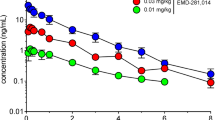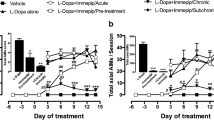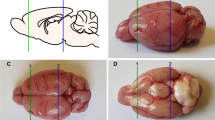Summary.
3,4-Methylenedioxymethamphetamine (MDMA) has recently been hypothesized to be effective against the symptoms of Parkinson's disease. Therefore we tested the effects of MDMA-derivatives in the rotational behavioural model. Male Sprague Dawley rats were lesioned unilaterally with 6-hydroxydopamine at the medial forebrain bundle. MDMA was administered at doses of 2.5, 5.0 and 10.0 mg/kg, its derivatives N-Methyl-1-(1,3-benzodioxol-5-yl)-2-butananamine (MBDB), 3,4-Methylenedioxy-N-ethylamphetamine (MDE) and 3,4-Methylenedioxyamphetamine (MDA) at 5.0 mg/kg respectively. All substances induced ipsilateral rotations, MDA being the most effective. MDMA induced rotations were attenuated by the selective serotonin reuptake inhibitor Citalopram but were only slightly reduced by pre-treatment with the selective serotonin synthesis inhibitor PCPA (para-chlorophenylalanine). The effects of MDMA can therefore not fully be explained by serotonin release or by dopaminergic activity of the drugs.
Similar content being viewed by others
Author information
Authors and Affiliations
Additional information
Received November 5, 2002; accepted February 12, 2003 Published online May 5, 2003
Authors' address: Dr. W. J. Schmidt, Zoological Institute, Neuropharmacology, University of Tübingen, Mohlstrasse 54/1, D-72074 Tübingen, Germany, e-mail: werner.schmidt@uni-tuebingen.de
Abbreviations ANOVA analysis of variance, GABA gamma-aminobutyric acid, MBDB N-Methyl-1-(1,3-benzodioxol-5-yl)-2-butananamine, MDA 3,4-Methylenedioxyamphetamine, MDE 3,4-Methylenedioxy-N-ethylamphetamine, MDMA 3,4-Methylenedioxymethamphetamine, MFB medial forebrain bundle, 6-OHDA 6-Hydroxydopamine, PCPA para-chlorophenylalanine, PBS phosphate-buffered saline, SEM standard error of the mean.
Rights and permissions
About this article
Cite this article
Lebsanft, H., Mayerhofer, A., Kovar, KA. et al. Is the Ecstasy-induced ipsilateral rotation in 6-hydroxydopamine unilaterally lesioned rats dopamine independent?. J Neural Transm 110, 707–718 (2003). https://doi.org/10.1007/s00702-003-0823-y
Issue Date:
DOI: https://doi.org/10.1007/s00702-003-0823-y




